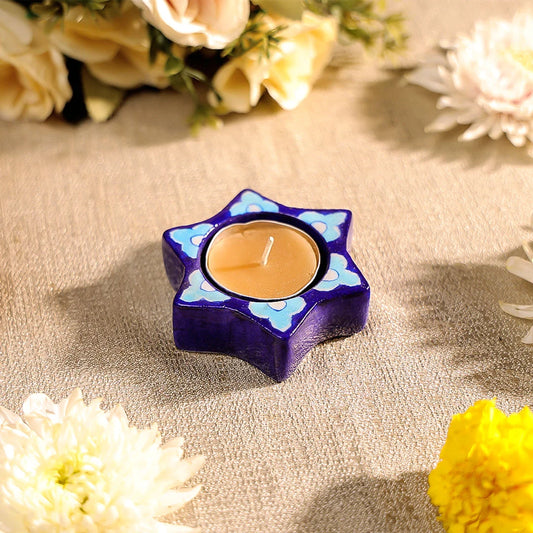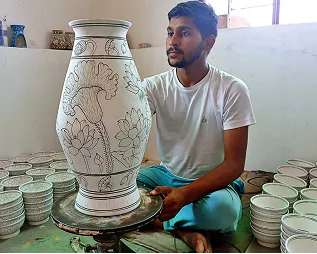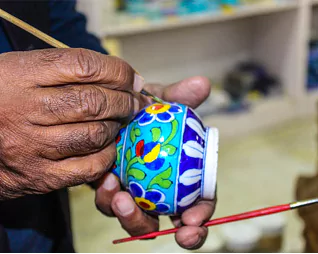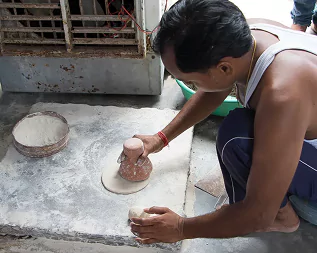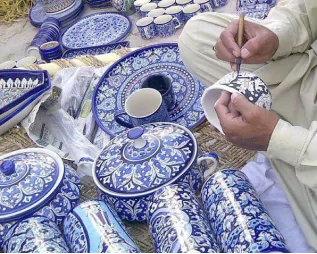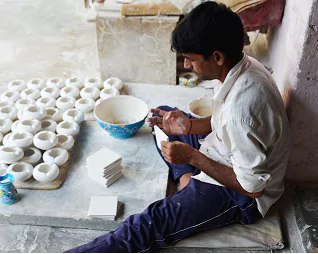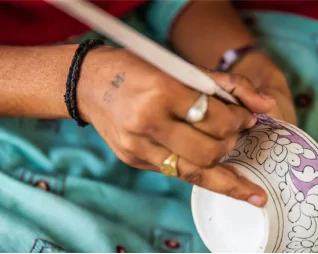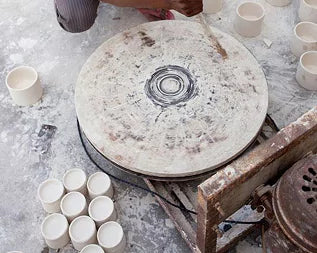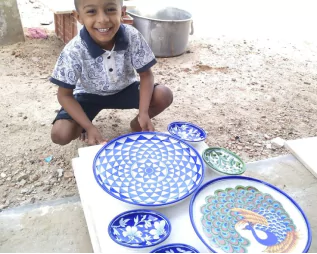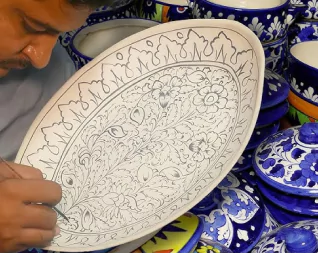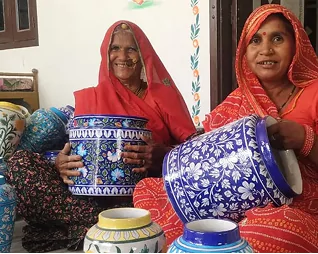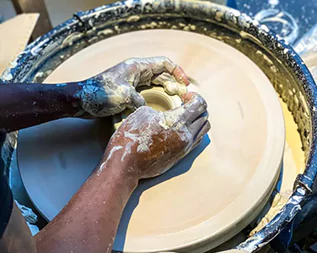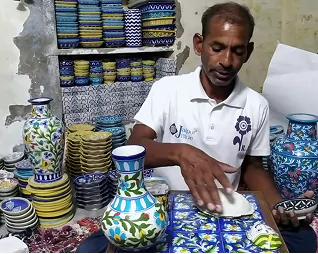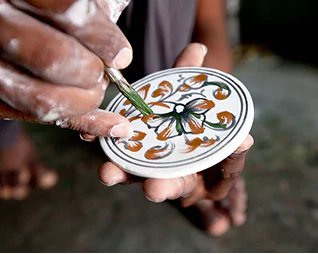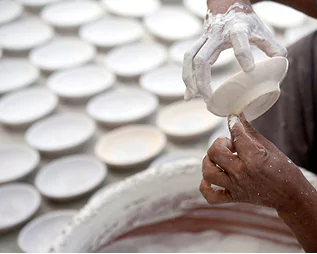History of Blue Pottery
Blue Pottery
Discover a craft where earth whispers history, colours dance with fire, and artisans shape timeless treasures known worldwide for their striking beauty.
-
1. Jaipur

-
2. Rajasthan

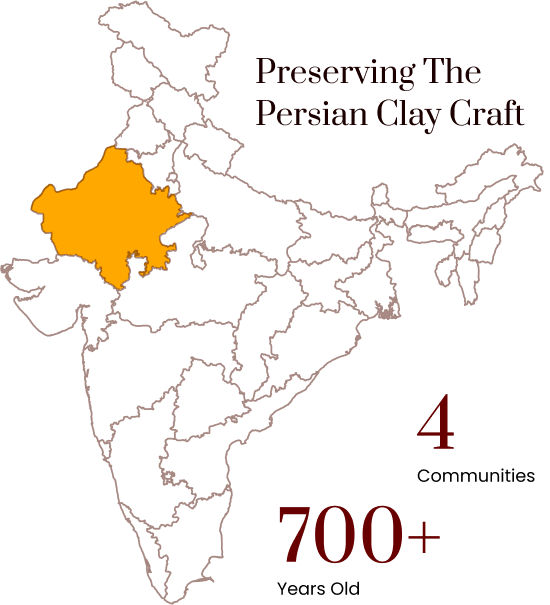
The Traditional Craft of Blue Pottery
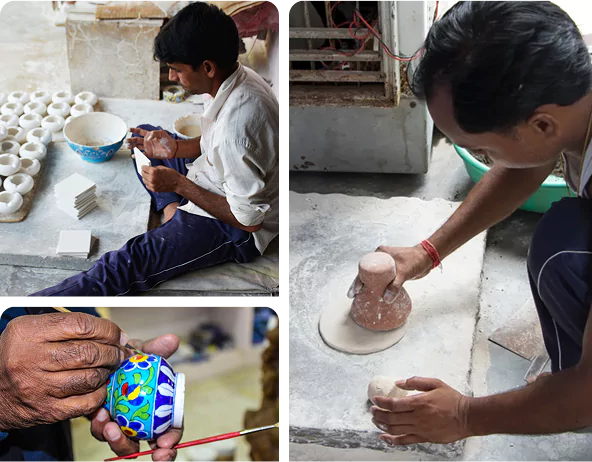
Unveiling the Journey of Handmade Artistic Treasures
Making the Dough: Quartz stone, glass, fuller’s earth, and natural gum are mixed with water to create a smooth non-sticky dough.
Moulding with Precision: Artisans hand-shape or press dough into moulds, slowly drying it to avoid cracks and achieve flawless pottery forms.
Painting Timeless Beauty: Intricate motifs in cobalt blue, green, or yellow, hand-painted with natural dyes, bring heritage alive through vivid artistry.
Glazing: A finely prepared glaze coats each masterpiece, balancing thickness and smoothness, to give the pottery its iconic sheen.
Firing the Pottery: Glazed pieces are kiln-fired at low temperatures, ensuring pottery designs remain vibrant, durable, and maintain their glossy charm.
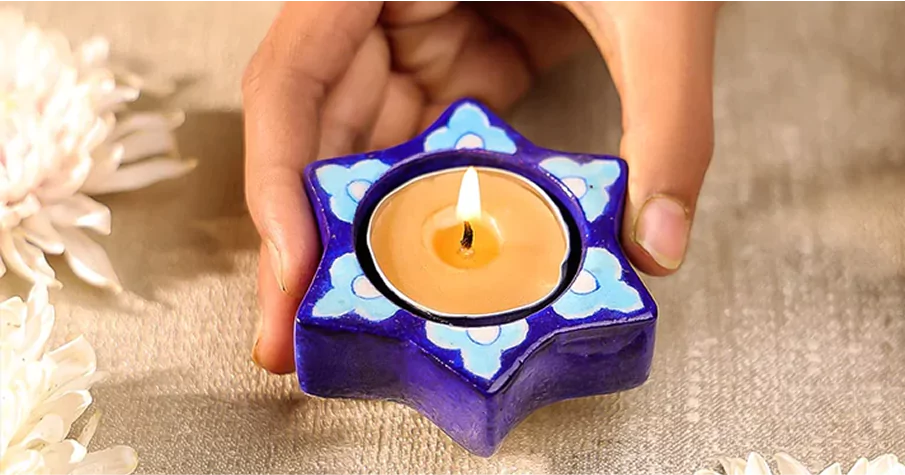
Enjoy 15% Off
Handcrafted elegance meets unbeatable prices—grab your favourite blue pottery pieces now at irresistible discounts!
Our Bestselling Blue Pottery Artefacts
Discover our best-selling masterpieces—handcrafted with timeless charm, painted in mesmerising hues, and glazed to perfection. Own the artistry everyone desires before it’s gone.
-
3" Blue Pottery Star Shaped...
(15% Off)Regular price₹ 765.00₹ 765.00Unit price per₹ 900.00Regular priceSale price
Craftsmen Perfecting Blue Pottery
Behind every masterpiece lies an artisan’s heart—calm hands preserving age-old traditions, crafting each pottery artefact with love, patience, and an unyielding passion for legacy.
The Origin Story
Tale Of Blue Pottery Across Centuries
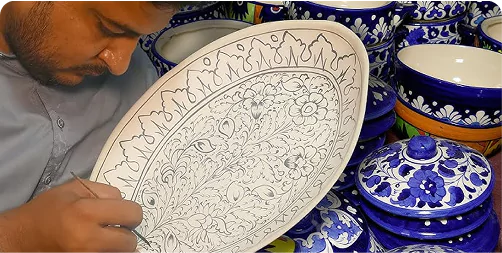
Craft Rooted in Royal Past
Blue Pottery originated in Persia and Central Asia, arriving in India with the Turks in the 14th century and flourishing under Mughal rule. In the 19th century, Jaipur embraced the craft under Maharaja Sawai Ram Singh II, who promoted artisans to continue the craft. Using quartz instead of clay, its signature cobalt-blue glaze remains an enduring hallmark.
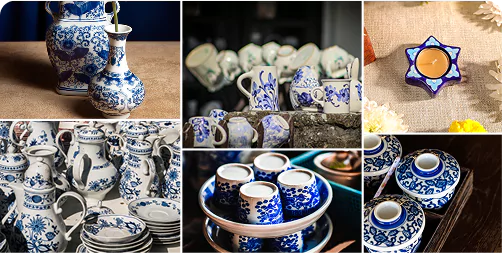
Tradition in Modern Light
Today, Jaipur is the heart of Blue Pottery, globally admired for its artistry and heritage. Over 25 workshops and numerous artisans keep the craft alive, producing decor and functional wares like plates, vases, and kitchenware. Balancing classic designs with contemporary motifs, Blue Pottery remains in high demand worldwide, sustaining artisan families and ensuring this fragile yet timeless craft continues to thrive.

Crafted With Community Spirit
Hands Preserving Rajasthan’s Legacy
Across Rajasthan, artistic communities breathe life into Blue Pottery—faithfully following traditional processes, materials, and age-old techniques. For artisans, it is more than craft; it is heritage preserved with pride. For families, it is a culture passed down through generations. And for the world, it is beauty now accessible through digital marketplaces, where timeless artistry finally finds the audience it has always deserved.
Preserving The Craft, Embrace The Legacy
The Finesse Of Clay Artistry
Each of our blue pottery masterpieces embodies timeless craftsmanship, natural finesse, and exquisite detailing, making our collection a rare blend of beauty, tradition, and enduring cultural pride.
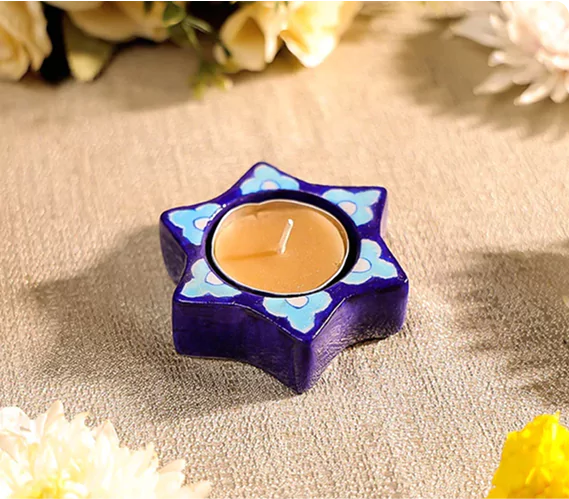
Ethnic India Handicrafts
Divine Pottery From Rajasthan’s Heart
Discover an exquisite collection of Blue Pottery, crafted by Rajasthan’s skilled artisans who preserve this timeless art in quiet alleys. Each piece you choose is more than décor—it is a lifeline, empowering artisan communities and ensuring this heritage continues to flourish for generations.
All About the Craft
Frequently Asked Questions
Curious about Blue Pottery? Our FAQs unravel traditions, techniques, and truths behind this timeless art form.
What makes Blue Pottery unique compared to traditional pottery?
What makes Blue Pottery unique compared to traditional pottery?
Blue Pottery is distinct because it does not use clay. Instead, it is made from a dough of powdered quartz, powdered glass, borax, gum, and other ingredients, fired at low temperatures and glazed with a distinctive blue dye made from cobalt oxide. This gives the pottery its characteristic translucent, glossy finish.
How did Blue Pottery come to be associated with Jaipur?
How did Blue Pottery come to be associated with Jaipur?
Although Blue Pottery has Turko-Persian origins dating back to the 14th century, it was introduced to Jaipur in the 17th century and flourished under royal patronage, especially during the reign of Maharaja Sawai Ram Singh II in the 19th century. He invited skilled artisans to Jaipur, thereby establishing the craft in the region.
What is the significance of the blue colour in Blue Pottery?
What is the significance of the blue colour in Blue Pottery?
The iconic blue colour in Blue Pottery mainly comes from cobalt oxide, which is used as a pigment in the glazing process. The blue hue is not only visually striking but also symbolic of the art’s Persian and Islamic influences.
Is Blue Pottery a dying craft?
Is Blue Pottery a dying craft?
Blue Pottery faced a decline in the mid-20th century due to the reluctance of artisans to share techniques and low demand. However, thanks to efforts by artists like Kripal Singh Shekhawat and patrons such as Gayatri Devi, Blue Pottery has experienced a revival and continues to be a vibrant craft today.
What kind of items are typically made with Blue Pottery?
What kind of items are typically made with Blue Pottery?
Blue Pottery is known for creating decorative and utilitarian items, including vases, plates, tiles, bowls, jars, and ornamental pieces. The designs often feature floral, geometric, and animal motifs inspired by Persian and Indian aesthetics.
- Choosing a selection results in a full page refresh.
- Opens in a new window.



